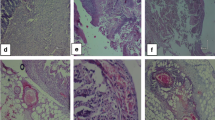Abstract
In contrast to adult surgery, the neonatal small intestine confronts the surgeon, depending on the age of the patient, with variable diameters of the intestine. Therefore, anastomoses are usually performed by hand with interrupted sutures. In the presented study, a new technique is demonstrated. An anastomosis in the distal ileum of Sprague Dawley rats was performed with a single clamp applicator (Anastoclip). Small bowel anastomoses were performed in 32 rats. The clipped bowel anastomosis was evaluated concerning stenosis, leakage, and adhesions in comparison to the sutured anastomosis. Tension test and X-ray examination were performed to measure the stability. The rats were sacrificed at day 3 or 14 after laparotomy. The clipped anastomosis is feasible, and faster to perform than the conventional hand-sutured anastomosis (Operation time: control group: 18.5 min versus clipped group 4 min; p > 0.05). Furthermore, there were differences in the mechanical stability, with higher tension forces needed for rupturing the clipped anastomosis. There were fewer stenoses (16.5 mm stenotic diameter in the control group versus 20.6 mm in the clipped group) and fewer adhesions in the group of the clipped anastomosis. Histological examinations were performed and did not show significant differences between the two groups. In the animal model presented, the clipped, intestinal, non-perforating anastomosis (CINPA) shows advantages compared to the common hand-sutured anastomosis.




Similar content being viewed by others
References
Smith GHH, Glasson M (1989) Intestinal atresia factors affecting survival. Aust N Z J 59(2):151–156
O’Connor A, Sawin RS (1998) High morbidity of enterostomy and its closure in premature infants with necrotizing enterocolitis. Arch Surg 133(8):875–880
Hedlund H, Hagberg S, Rubenson A, Sillen U (1989) Pediatr Surg Int 4(4):291–294
Della Vecchia LK, Grosfeld JL, West KW, Rescorla FJ, Schere LR, Engum SA (1998) Intestinal atresia and stenosis: a 25-year experience with 277 cases. Arch Surg 133(5):490–496
Ade-Ajavi N, Kiely E, Drake D, Wheeler R, Spitz L (1996) Resection and primary anastomosis in necrotizing enterocolitis. J R Soc Med 89:385–388
Haberlik A, Hollwarth ME, Windhager U, Schober PH (1994) Problems of ileostomy in necrotizing enterocolitis. Acta Paediatr Suppl 396:74–76
Ang BK, Cheong D, Teh E, Teoh TA, Tsang C (1999) Skin stapled bowel anastomosis in a canine model. Singapore Med J 40(2):81–83
Jonsson T, Hogstrom H (1992) Effect of suture technique on early healing of intestinal anastomoses in rats. Eur J Surg 158(5):267–270
Hendriks T, Mastboom WJ (1990) Healing of experimental intestinal anastomoses. Parameters for repair. Dis Colon Rectum 33(10):891–901
Bundy CA, Jacobs DM, Zera RT, Bubrick MP (1993) Comparison of bursting pressure of sutured, stapled and BAR anastomoses. Int J Colorectal Dis 8(1):1–3
Mansson P, Zhang XW, Jeppsson B, Thorlacius H (2002) Anastomotic healing in the rat colon: comparison between a radiological method, breaking strength and bursting pressure. Int J Colorectal Dis 17(6):420–425
Tirabassi MV, Banever GT, Moriarty KP, Konefal S, Reiter E, Wait R (2004) Feasibility of throcoscopic U-clip esophageal anastomosis: an alternative for esophageal atresia reconstruction. J Pediatr Surg 39(6):851–854
Inomata T, Sakita K, Ito Y, Ninomiya H, Kashiwazaki N, Sonoki S, Hisamatsu S, Nagai T (2003) A simple method for sutureless gastrointestinal anastomosis in rat. Exp Anim 52(4):345–348
Howell GP, Ryan JM, Morgans BT, Cooper GJ (1991) Assessment of the use of disposable skin staplers in bowel anastomoses to reduce laparotomy time in penetrating ballistic injury to the abdomen. Ann R Coll Surg Engl 73(2):87–90
Edwards DP, Galibraith KA (1998) Colonic anastomosis in the presence of fecal peritonitis using a disposable skin stapler. J Invest Surg 11(4):267–274
Author information
Authors and Affiliations
Corresponding author
Rights and permissions
About this article
Cite this article
Holland-Cunz, S., Chmelnik, M., Roll, M. et al. The clipped intestinal non-perforating anastomosis of small bowel: a new technique. Pediatr Surg Int 23, 87–93 (2007). https://doi.org/10.1007/s00383-006-1803-8
Accepted:
Published:
Issue Date:
DOI: https://doi.org/10.1007/s00383-006-1803-8




